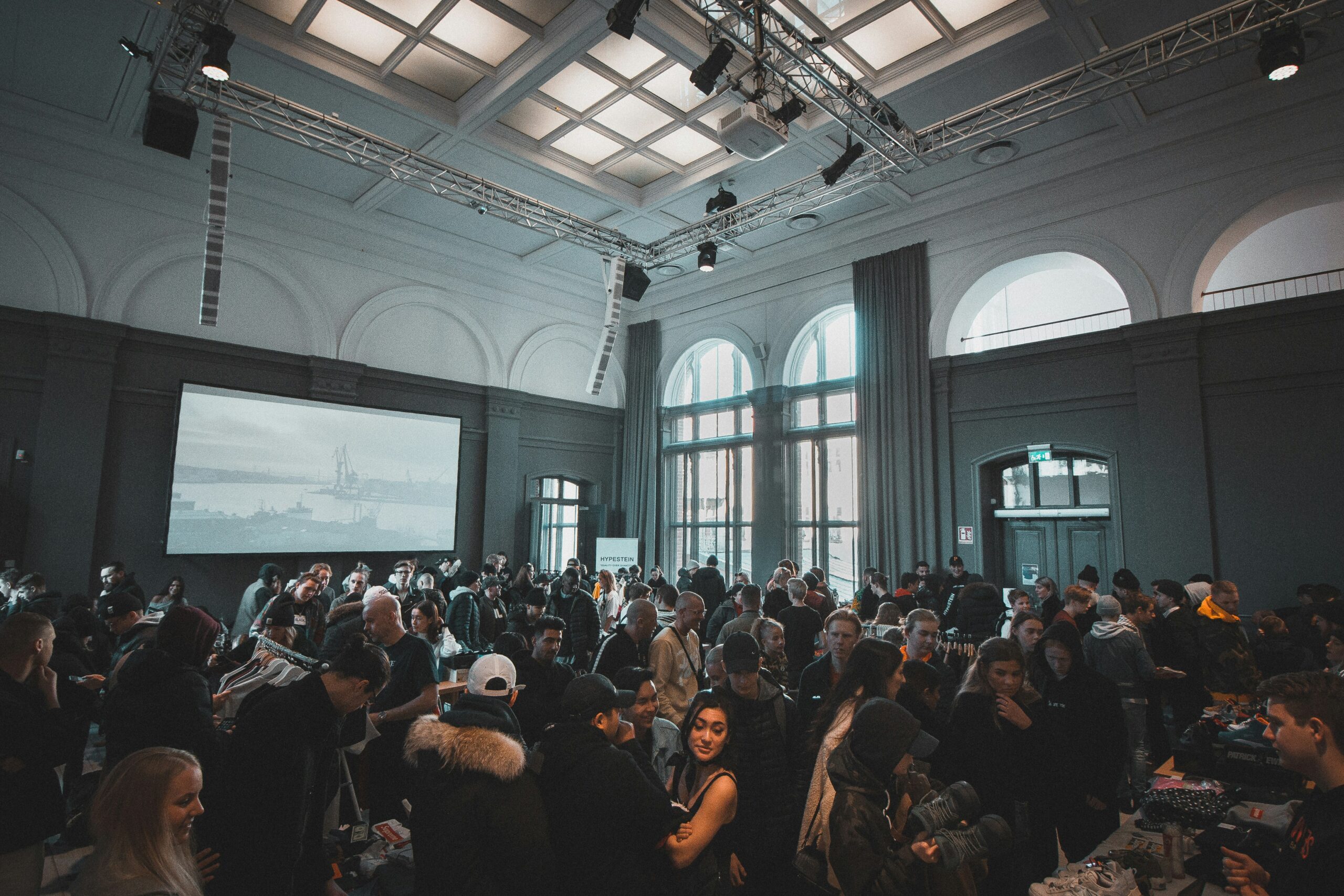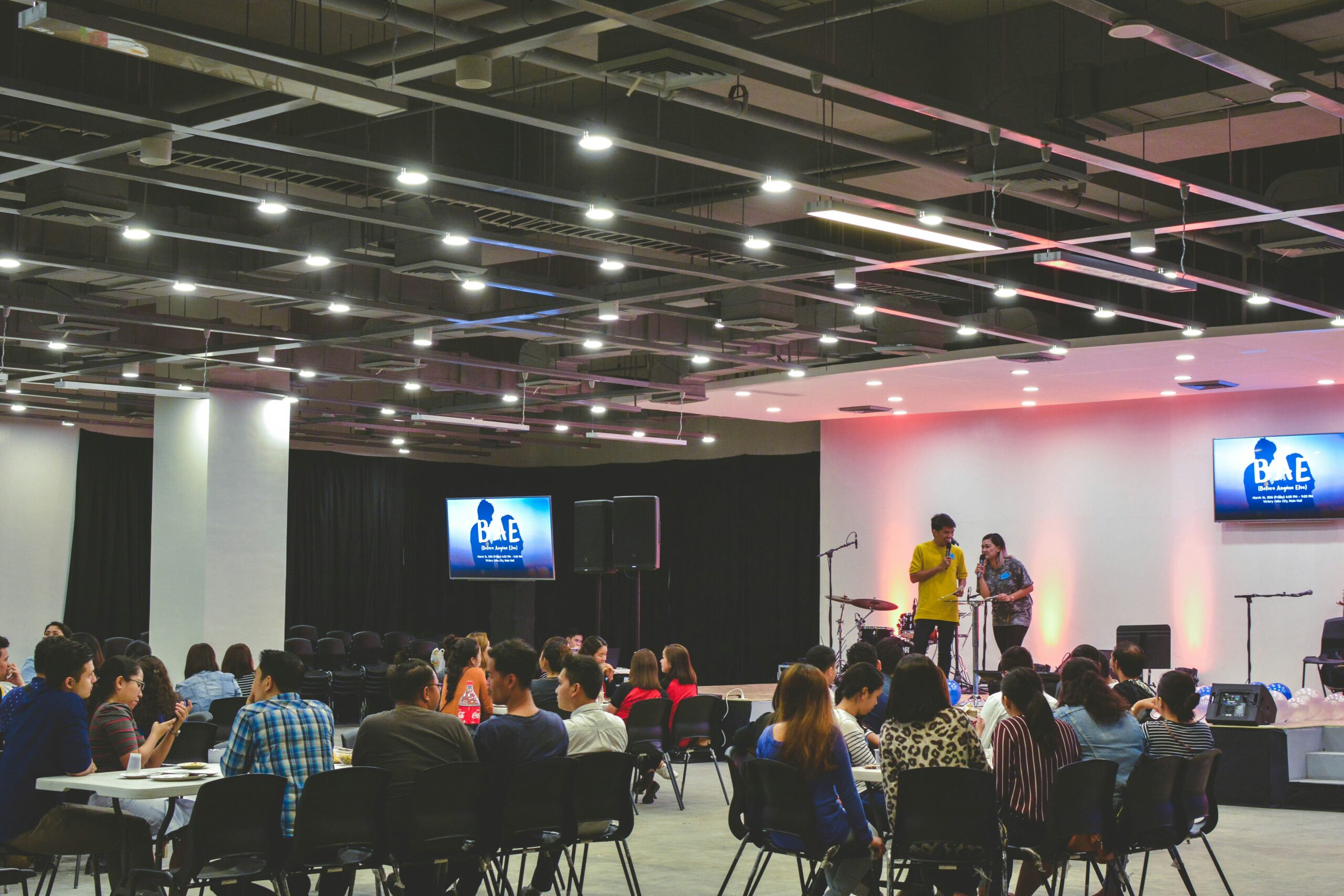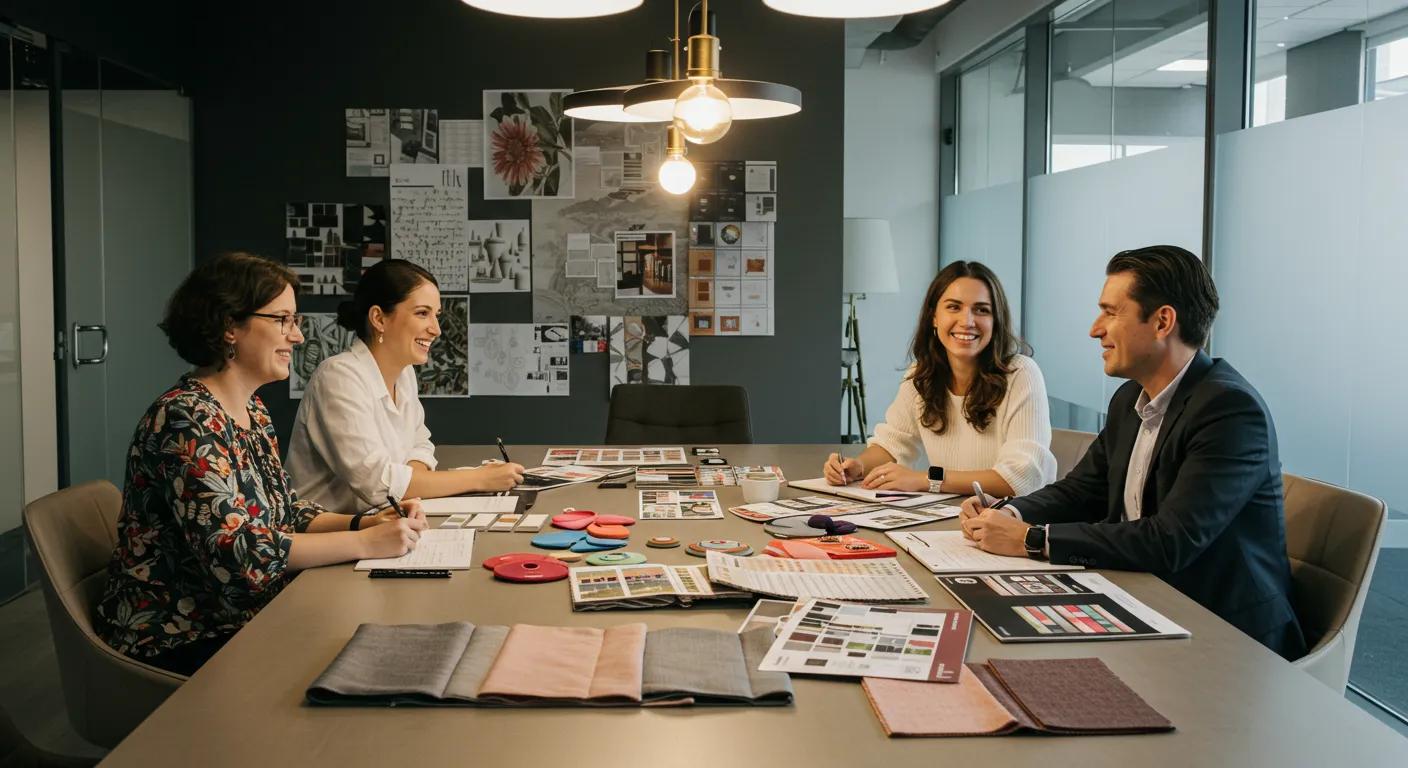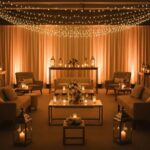Decorative event signage, also known as directional décor, goes beyond guiding guests from one point to another. It plays a key role in shaping the atmosphere of an event, reinforcing branding, and improving the guest experience. Whether you’re planning a wedding, corporate event, or trade show, well-designed signage helps create smooth traffic flow while adding visual interest to the space. From welcome boards to digital wayfinding kiosks, each sign is a chance to communicate clearly and leave a lasting impression.
Key Takeaways
- Directional décor helps guests navigate an event smoothly and confidently.
- Signage can reinforce an event’s theme and brand through fonts, colors, and style.
- Social events benefit from personalized signs like seating charts and welcome boards.
- Corporate events use branded, modern signage to guide large groups efficiently.
- Materials matter—indoor and outdoor signs need to match the venue and weather.
- Digital and interactive signage adds flexibility and increases guest engagement.
What Is Directional Décor and Why Does It Matter for Events?

Directional décor refers to event signage that not only guides guests through a venue but also enhances the overall atmosphere. Featuring elements like banners, wall signs, and branded graphics, these signs help guests locate key areas such as registration, restrooms, and dining while reinforcing the event’s brand identity and theme. This combination of functionality and style transforms a standard layout into a memorable experience, ensuring that every element—from colors and logo to creative designs reminiscent of a wedding reception or a bachelorette party—is carefully coordinated.
Enhances Guest Navigation
Clear, well-placed signage reduces guest confusion, minimizes stress, and prevents traffic bottlenecks. When attendees can easily find key areas—like registration, restrooms, dining areas, and exits—they feel more at ease and in control of their experience.
Directional signs placed at critical junctions promote smooth transitions between different event zones. Whether you’re guiding guests from a ceremony to a cocktail hour or helping them navigate a large trade show floor, strategic signage keeps the event flowing naturally without the need for constant staff direction.
Reinforces Event Branding & Theme
Signage offers a subtle but powerful opportunity to reinforce your event’s identity. Through consistent use of branded colors, logos, and typography, signs help maintain a visual thread that ties every element of the event together.
From matching the aesthetic of printed invitations to complementing stage backdrops or centerpieces, decorative signage adds a polished and cohesive look. For corporate events, it reinforces brand recognition; for weddings and social gatherings, it reflects the hosts’ unique style and personality.
Boosts Engagement & Shareability
Today’s guests are always on the lookout for visually engaging elements they can share. Well-designed signage with creative graphics, interactive displays, or witty messaging provides perfect photo opportunities that naturally encourage social media sharing.
Personalized signs—like a couple’s monogram, a branded hashtag wall, or a digital selfie station—draw attention and invite interaction. These Instagram-worthy details not only elevate the event experience but also extend your reach as attendees post and tag their experiences online.
Social Events: Signage Ideas for Weddings, Showers, and Celebrations

In social gatherings like weddings, bridal showers, and milestone celebrations, signage plays a dual role: it informs guests and elevates the event’s visual storytelling. From setting the tone at the entrance to guiding guests through transitions between ceremony and reception, decorative signs help maintain flow while adding charm and personality. Every sign can reflect the host’s unique aesthetic and create memorable photo moments for attendees.
Essential Signage Types
Certain signage types are staples at social events. Welcome signs greet guests with a warm, personalized touch, often including the names of the hosts or couple and the event date. Seating charts help streamline guest movement into dining areas, while directional arrows point toward key locations such as restrooms, gift tables, bars, or ceremony sites.
When a wedding or celebration spans multiple spaces—like a garden ceremony followed by an indoor reception—signage becomes critical in preventing confusion. A combination of informative and decorative signage ensures guests know exactly where to go without disrupting the aesthetic flow.
Style Options
The beauty of signage for social events lies in the ability to customize. Rustic wooden boards with hand-lettered calligraphy and floral embellishments bring a romantic, natural charm to outdoor or vintage-themed weddings. For a more modern or glamorous look, acrylic panels, mirrored signs, and gold foil lettering can add a sleek, polished finish.
Hosts can coordinate signage materials and designs with other décor elements such as table settings, floral arrangements, or the invitation suite. These cohesive design touches turn simple directional signs into integral parts of the event’s overall look.
Tips for Placement & Visibility
Even the most beautifully designed sign won’t serve its purpose if guests can’t see it. Placement is key: signs should be positioned at eye level, near entrances, or at major transition points where guests need direction or confirmation.
Avoid overcrowding an area with too many signs or overly ornate visuals that compete with readability. In dim or evening settings, accent lighting or backlit signage can improve visibility and add ambiance. Always test placement during setup to ensure that important signs are visible from multiple angles and not blocked by décor or crowd flow.
Corporate & Trade Events: Function Meets Brand Strategy

At corporate events and trade shows, signage is more than decoration—it’s a communication tool that supports branding, clarity, and efficiency. Whether guiding attendees through a large conference center or directing traffic across a trade show floor, every sign should reflect the organization’s identity while facilitating a smooth, stress-free experience. Well-designed signage reinforces professionalism, ensures consistency, and helps maximize attendee engagement in high-stakes environments.
Must-Have Corporate Signage
Corporate gatherings typically require a structured approach to signage. Key signage types include registration area signs, directional guides for breakout sessions, arrows to keynote stages, and venue-wide wayfinding maps. These elements reduce confusion, streamline check-in processes, and help attendees get where they need to be without delay.
Effective wayfinding in a professional setting supports productivity by minimizing downtime and eliminating the need for constant verbal assistance from staff. Clear, well-placed signage ensures that attendees can move confidently through the space—even in complex venues with multiple rooms or tight schedules.
Branded & Professional Finishes
Unlike social events, corporate signage must blend utility with brand consistency. Modern fonts, clean layouts, and professional materials like acrylic, aluminum, or high-quality digital screens give the signage a polished, sophisticated look. Colors, logos, and design elements should align with corporate identity guidelines, reinforcing brand recognition throughout the event.
This cohesive visual language—repeated across stage backdrops, digital kiosks, and directional signs—conveys professionalism and attention to detail. Even simple signs can be elevated with refined finishes and consistent graphic treatment, contributing to a seamless brand experience.
Enhancing Flow and Efficiency
Corporate and trade events often involve fast-paced schedules and multiple touchpoints. Signage equipped with QR codes allows attendees to access digital agendas, maps, or session details on their mobile devices, reducing paper waste and offering real-time updates.
Additionally, digital signage and touchscreen kiosks can adapt quickly to schedule changes or highlight time-sensitive announcements. This level of responsiveness not only improves crowd flow but also reduces the burden on staff and improves the overall perception of the event’s organization and professionalism.
Best Practices for Implementing Directional Décor

Even the most beautifully designed signs can fall flat without the right strategy behind them. Effective implementation of directional décor requires thoughtful coordination, visual planning, and clear communication across teams. From site walkthroughs to final installation, each step plays a crucial role in ensuring signage supports the event’s flow, enhances the guest experience, and maintains visual harmony with the overall design. Below are key best practices to help planners execute signage that is both functional and visually integrated.
Planning Ahead
Begin by conducting a venue walkthrough well in advance of the event. This allows you to identify high-traffic zones, transition points, and potential visibility challenges. It also helps you determine where signage will be most impactful—such as entrances, exits, intersections, and focal points like registration desks or stages. From there, draft a comprehensive signage placement plan that outlines the type, size, and purpose of each sign. This blueprint should align with the event’s layout and flow, helping you avoid last-minute guesswork or cluttered setups on event day.
Collaborating with Designers & Vendors
Work closely with graphic designers and signage vendors to ensure each element reflects the event’s branding and visual style. Providing mockups or mood boards that outline color schemes, fonts, logos, and desired materials will help maintain design consistency across all signage types.
Vendor coordination is essential for timely production, delivery, and installation. Whether you’re sourcing eco-friendly materials or integrating digital elements, clear communication with partners ensures the final signage matches the plan and blends seamlessly with décor, lighting, and staging.
Installation Checklist
Before the event begins, conduct a visibility test for all signage. Check that each sign is clearly readable from a distance, positioned at the correct height, and not obstructed by furniture, lighting, or décor. Ensure every piece has a clean, professional finish and strikes the right balance between form and function. Temporary signage should still look intentional, and permanent elements (like digital kiosks or freestanding signs) should be securely installed to avoid safety risks or visual distraction. A well-executed setup not only enhances flow but also reflects positively on the professionalism of the event as a whole.
How Do You Choose the Right Directional Décor Provider?

Selecting a provider involves reviewing their portfolio, ensuring they can customize designs to match the event theme, and verifying full-service capabilities from design through installation. Client testimonials and transparent pricing also help gauge whether a provider aligns with the event’s focus on guest experience and creative décor.
How Does Full-Service Directional Décor Simplify Event Planning?
Full-service providers handle every facet of signage—from conceptualization and design to installation and removal—which eases the workload on planners. This integrated service minimizes miscommunication and installation errors, ensuring all signage aligns perfectly with the event’s aesthetic and functional needs.
Why Is Guest Experience a Priority When Selecting Signage?
Effective signage transforms event navigation, directly impacting guest satisfaction. Clear, attractive, and contextually relevant signs help guests feel informed and relaxed, leading to higher engagement, better attendance, and positive word-of-mouth—essential for a successful, memorable event.
Frequently Asked Questions
What is directional décor in event planning?
Directional décor refers to signage that helps guests find their way while also enhancing the design and theme of an event.
How does decorative signage improve the guest experience?
It provides clear directions, reduces confusion, and creates a cohesive visual journey from entrance to exit.
What materials are best for event signage?
For indoor events, foam board or acrylic is popular. For outdoor use, consider metal or weather-resistant plastics. Sustainable options like bamboo and recycled wood are also available.
Can signage be both decorative and functional?
Yes. The best event signs serve a practical purpose while also contributing to the look and feel of the event.
How does digital signage help at large events?
Digital signage offers real-time updates, interactive features, and dynamic visuals—ideal for conferences and fast-changing schedules.
What should I consider when placing event signs?
Ensure signs are at eye level, well-lit if needed, and placed in high-traffic areas like entrances, restrooms, and food stations.
Final Thoughts
Directional décor is key to transforming events by blending functionality with creative design. It effectively guides, informs, and delights guests, reducing stress and reinforcing a strong brand identity. With modern solutions like digital signage and eco-friendly materials, planners have powerful tools to create efficient, visually appealing environments. Choosing the right signage solutions ensures smooth guest navigation and leaves a lasting impression that contributes to overall event success.






